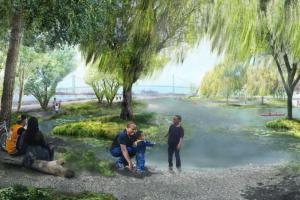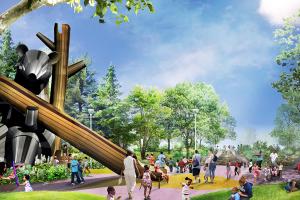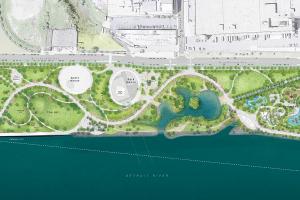A Walk in the Park
Tuesday, November 9, 2021
N
estled in close proximity to the neighborhoods of Corktown and Mexicantown in Southwest Detroit is the site of the future Ralph C. Wilson, Jr. Centennial Park, which will undergo a substantial transformation following a groundbreaking next spring. Once the nonprofit Detroit Riverfront Conservancy completes renovation of the 22-acre site in 2024, the park will include a water garden, basketball courts, and a children’s play structure as well as possible boat rentals and ice skating. A small island will provide a natural habitat.
The park will not only serve those neighborhoods but also realize the longtime dreams of three U-M alumni.
“It will create an environment where people of every race, age, or occupation come together,” says Matt Cullen, ’78, chairman of JACK Entertainment as well as chair of the Detroit Riverfront Conservancy board of directors. “It will be an incredibly vibrant tapestry of community.”
Cullen says the idea for connecting Huron-Clinton Metroparks to a potential west riverfront park originated several years ago. He credits Mark Wallace, MPP’04, president and CEO of the Detroit Riverfront Conservancy, and Robert Marans, ’57, PhD’71, U-M emeritus professor of architecture and urban and regional planning and research professor emeritus at the Institute for Social Research, as being instrumental in “bringing this to a successful conclusion.”
The collaboration began in 2004 when Wallace, then a graduate student in the Ford School of Public Policy, tackled a unique assignment: a weekend-long exercise to research and identify a potential Detroit location for a new Huron-Clinton Metropark. Professor Elisabeth Gerber, ’86, MA’89, PhD’91, who taught the class, says a component of the course was a large-scale role-playing simulation where students participate in a real-world public policy challenge.
The idea to focus the exercise on a Detroit location came from Marans, then Gerber’s colleague and a professor in the College of Architecture & Urban Planning. He has also served on the boards of the Detroit Riverfront Conservancy and the Huron-Clinton Metroparks and has devoted years of service to the parks. Seeing the value of bringing a Metropark to Detroit, he thought that a simulation exercise examining the pros and cons of different sites would be a perfect class exercise. He’s long been eager to have Huron Clinton-Metroparks join forces with the Detroit Riverfront Conservancy to create a park in Detroit.
“It’s really exciting,” says Marans. “It’s great to see the Metroparks serving Detroiters through the vehicle of the Detroit Riverfront Conservancy.”
Wallace, meanwhile, had worked as a teacher in the Detroit Public Schools for three years before he started graduate school. “I was obsessed with Detroit,” he says. That teaching experience opened his eyes to how isolated students were; few had spent time beyond the boundaries of their city. He saw parks as providing a key connection with their natural environment.
So he was excited with Gerber’s assignment. He was also impressed with Cullen—who at the time led the real estate team for General Motors—when he was a guest speaker in Gerber’s class and advocated for a park to be located along the riverfront.
“He was clearly a visionary who was not just talking about ideas. He was actually making things happen,” Wallace says. Eager for his advice, Wallace approached Cullen after the class presentation. Cullen encouraged Wallace to call his assistant and set up a time to chat. Protective of Cullen’s busy schedule, the assistant didn’t forward several of Wallace’s messages.
However, the two crossed paths at a meeting a few months after Wallace graduated in 2004 and was working for a real estate development company in Detroit. Cullen remembers meeting Wallace during Gerber’s class and his enthusiasm for creating a public space in the city of Detroit; he was eager to continue the conversation.
Wallace was assigned to a team working on the redevelopment of the GM Plaza and Promenade on the riverfront. It allowed him to help bring the vision that Cullen presented to reality.
Gerber believes that some value came from the initial class conversations about the views and interests of a broader set of stakeholders. “So I’ll take a little credit for the collaboration between the Huron-Clinton Metroparks and the Detroit Riverfront Conservancy,” she jokes.
Wallace seconds that notion. “I think this idea was really germinated in that classroom.” Though there were many discussions about bringing a Metropark to the city before 2004, Gerber’s classroom “was a place where that idea really started to stick with the folks who have ended up moving forward this partnership.”
Wallace adds, “My heart’s desire is for this to be a place where people from Detroit are interacting with people they don’t know. We’d like this to be a place where you can make a new friend or have a little quick conversation with a stranger. I think that’s critically important for our community.”
Written by Julie Halpert, ’84, is an award-winning freelance journalist with more than three decades of experience writing for many national publications, including The New York Times, The Wall Street Journal, CNBC, and AARP.




